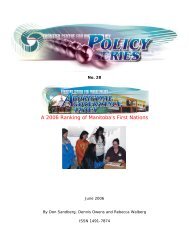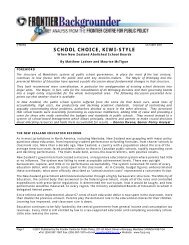POLICYSERIES - Frontier Centre for Public Policy
You also want an ePaper? Increase the reach of your titles
YUMPU automatically turns print PDFs into web optimized ePapers that Google loves.
LITTLE CRECHE ON THE PRAIRIES<br />
P O L I C Y S E R I E S<br />
10<br />
ALBERTA<br />
Alberta’s child care policy differs from<br />
its Prairie neighbours in many significant<br />
ways. In particular, it does not discourage<br />
the participation of the <strong>for</strong>-profit daycare<br />
sector. This commitment to equality<br />
stretches back many years. Between<br />
1980 and 1983 the province engaged<br />
in a lengthy dispute with Ottawa over a<br />
Canada Assistance Plan requirement that<br />
federal CAP money could only be spent on<br />
non-profit daycares. This led Alberta to<br />
establish its own provincial daycare funding<br />
program that provided subsidies to nonprofit<br />
and <strong>for</strong>-profit centres on an equal<br />
basis, rather than relying on tied federal<br />
money. 13<br />
Recent government policies have solidified<br />
this long-standing commitment to parental<br />
choice and diversity within the child care<br />
sector. Alberta provides subsidies without<br />
ideological bias to both <strong>for</strong>-profit and nonprofit<br />
centres. It also funds a wide variety<br />
of alternative child care options — including<br />
the Kin Child Care Funding Program, which<br />
provides funds <strong>for</strong> parents to pay close<br />
relatives in certain situations. Recent<br />
additions to child care policy in Alberta<br />
include the Space Creation Innovation<br />
Fund, online worker certification, increases<br />
in wage supplements and subsidies and<br />
the creation of a new category of licensed<br />
home child care in which two caregivers<br />
can look after up to 10 children in their<br />
residence. 14 There has also been a large<br />
increase in the provincial child care budget<br />
over the past three years. Alberta is the<br />
only Prairie province to have a majority of<br />
<strong>for</strong>-profit daycares. 15<br />
Survey evidence suggests Alberta families<br />
have the lowest level of preference <strong>for</strong><br />
institutional child care in the country, with<br />
more Alberta mothers opting to stay at<br />
home with their children. 16<br />
“<br />
Perhaps because of this, Alberta is slightly<br />
below the national average with regulated<br />
spaces <strong>for</strong> 17 percent of all children<br />
aged 0-5 (see Table 1, next section).<br />
Nonetheless, the population boom in<br />
Alberta has led to a provincial policy<br />
objective to create more child care spaces.<br />
Alberta provides subsidies<br />
without ideological bias to<br />
both <strong>for</strong>-profit and non-profit<br />
centres. It also funds a wide<br />
variety of alternative child<br />
care options...<br />
”<br />
Recently Alberta instituted the country’s<br />
first accreditation program <strong>for</strong> child care. 17<br />
This policy establishes subsidies and<br />
other benefits <strong>for</strong> centres and family day<br />
homes that meet advanced standards <strong>for</strong><br />
child care services. This policy puts the<br />
focus on quality, rather than ownership or<br />
management status of a particular daycare<br />
centre.<br />
The Alberta government has promised to<br />
support the creation of 14,000 additional<br />
child care spaces between 2008 and 2011. 18<br />
After just one year, the province is already<br />
half way to its target — with approximately<br />
6,500 new spaces funded or established. 19<br />
FCPP POLICY SERIES NO. 58 • MAY 2009<br />
© 20O8<br />
FRONTIER CENTRE


















